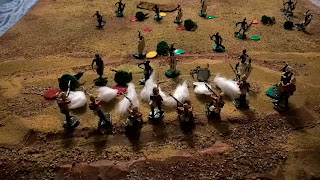It was one of those quiet names when a friend brought across a "game" ...
Somewhere in South Africa a peaceful landscape is about to be the scene of dreadful slaughter. A British Infantry patrol is about to stumble of a group of young Zulu Warriors (see below):
As the British Patrol crests the hill Pvt Jones 21121 calls out the alarm as the Zulu rise as one (see below):
The officer, Lt. Adamson, quickly calls his men to form a firing line (see below):
The Zulu's meanwhile chant a challenge (see below):
The they (the Zulu) set off at a run as the first volley erupts from the "Thin Red Line" (see below, teh first volley is at maximum range and is an abject failure with only one slight wound to a Zulu, stunning him briefly, the others charge on):
The second volley is slightly more telling. Again the range is in the maximum band and the Zulu herd keeps coming. It is clear now that the odds are approximately three to one. One Zulu in effect is (ineffectually) firing a captured rifle, while the British Officer is outside of pistol range (see below):
The rifles take four segments to load and fire which means the Zulus travel a good twelve inches before they hear the rip of the bullets (see below):
The range bracket drops to effective range file range, the Zulus are getting dispersed but still project a formidable force and threat factor. These Zulus are running on something "more than" adrenaline, being enhanced by their "medicine bags" (see below):
Perhaps the British have two chances to deliver telling rounds before it becomes a contest of bayonet and Assegai (see below, too few fall for the British players liking):
The same volley taken from a different angle (see below):
One final volley fire to the badly mauled but not defeated (and still very dangerous) Zulu foe (see below, the 'Thin Red Line' looks very thin; note the officers pistol has already been extensively used):
The dramatic British angle of that final volley which tore through Zulu flesh (see below):
But those Zulus still keep a coming as the combat now enters a ferocious hand-to-hand phase where the Zulus numbers may well tell (see below):
The first round of combat goes down as a draw to the British right hand side of the line (where Lt. Adamson is locked in a mortal do-or-die, or rather sword-to-Assagai combat) but the British gain a temporary to their left hand side as a second wave of Zulu come in (see below):
Zulu numbers begin to tell. Lt. Adamson falls, his troops meanwhile are more pragmatically interested in their own survival (see below):
This is where even a wounded Zulu is a killer. The wounds have only slowed them down. They are not out of the fight. Another redcoat falls. Now there are only six defenders heavily outnumbered but with nothing to lose. Surrender is not an option (see below):
Half the British have fallen. One Zulu warrior in particular has felled the officer (the poor Lt. Adamson with now widowed wife) and two "rankers", but is in the process of taking on him fourth combat (see below):
Bodies pile up and chaos ensues. Half the Zulus are either dead or dying but the British are spent (see below):
The grim struggle moves to its ugly conclusion. The "indestructible paladin of a Zulu warrior" falls to the three remaining bayonets of the British (he had outstripped his supports and left himself vulnerable and exposed). The remaining three British Soldiers rally together in a final desperate stand (see below):
Three become two as one is disarmed and then finished off (see below):
The final two suffers wounds which only delays the inevitable (see below):
Finally it is over except for the moaning wounded. As many Zulu will probably die of their wounds as did in the fight (see below)
The South African hill bears no name to mark this engagement. No record of it will be found in the annals of the British Army as no survivors remained to tell the tale . Too few Zulus remember it as one amongst many. The wheel of time moves on. Only the carrion birds were happy as they feasted (see below):
An "entertaining" engagement. The 1972 rules are in the form of a time and motion study where 3:1, as per General Longstreet's dictum held sway and took the day with mathematical precision.
Note: The "Rules" used called - Skirmish Wargames Colonial 1850-1900 Period
Rules for the conduction of Colonial skirmish in miniature using tiny but perfect model figurines
Written by Michael R Blake, Stephen Curtis, Ian M Colwill and Edwin J Herbert
Printed circa 1972 (see below):
The rules to be fair in the real-time games mechanics and weapons characteristic sense still worked very well, however more modern sense of morale was more left to the player.
PS: Also not bad for forty year old Hinchliffe Figures either ;)
Here's to the old ones figures including the few he has still to get painted from the original collection! Myself I would be interested in painting compatible Perry's in 28mm (Zulu or British).
























3 comments:
Excellent write up!
You make a good point on morale. There is no way a European group would take 50% casualties without thinking twice...
Makes me want to get a packet of 28mm Zulus and a Line Red Line from the likes of the Perry twins ;)
Cheers for that rules link :)
Much appreciated
Post a Comment